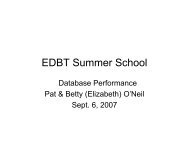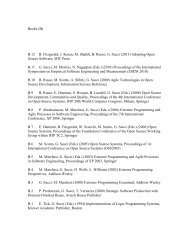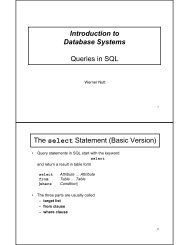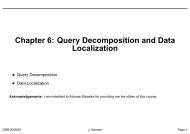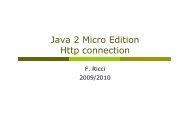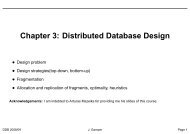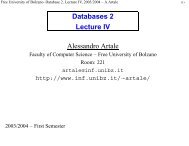J2ME Building Blocks for Mobile Devices - Oracle
J2ME Building Blocks for Mobile Devices - Oracle
J2ME Building Blocks for Mobile Devices - Oracle
Create successful ePaper yourself
Turn your PDF publications into a flip-book with our unique Google optimized e-Paper software.
<strong>J2ME</strong> <strong>Building</strong> <strong>Blocks</strong> <strong>for</strong><br />
<strong>Mobile</strong> <strong>Devices</strong><br />
White Paper on KVM and the Connected, Limited<br />
Device Configuration (CLDC)<br />
Sun Microsystems, Inc.<br />
901 San Antonio Road<br />
Palo Alto, CA 94303 USA<br />
650 960-1300 fax 650 969-9131<br />
May 19, 2000
Copyright © 2000 Sun Microsystems, Inc.<br />
901 San Antonio Road, Palo Alto, CA 94303 USA<br />
All rights reserved. Copyright in this document is owned by Sun Microsystems, Inc.<br />
Sun Microsystems, Inc. (SUN) hereby grants to you at no charge a nonexclusive, nontransferable,<br />
worldwide, limited license (without the right to sublicense) under SUN's intellectual property rights that are<br />
essential to practice the Java 2 Plat<strong>for</strong>m Micro Edition, K Virtual Machine (KVM) or <strong>J2ME</strong> CLDC Reference<br />
Implementation technologies to use this document <strong>for</strong> internal evaluation purposes only. Other than this<br />
limited license, you acquire no right, title, or interest in or to the document and you shall have no right to<br />
use the document <strong>for</strong> productive or commercial use.<br />
RESTRICTED RIGHTS LEGEND<br />
Use, duplication, or disclosure by the U.S. Government is subject to restrictions of FAR 52.227-14(g)(2)(6/87)<br />
and FAR 52.227-19(6/87), or DFAR 252.227-7015(b)(6/95) and DFAR 227.7202-1(a).<br />
SUN MAKES NO REPRESENTATIONS OR WARRANTIES ABOUT THE SUITABILITY OF THE<br />
SOFTWARE, EITHER EXPRESS OR IMPLIED, INCLUDING BUT NOT LIMITED TO THE IMPLIED<br />
WARRANTIES OF MERCHANTABILITY, FITNESS FOR A PARTICULAR PURPOSE, OR NON-<br />
INFRINGEMENT. SUN SHALL NOT BE LIABLE FOR ANY DAMAGES SUFFERED BY LICENSEE AS A<br />
RESULT OF USING, MODIFYING OR DISTRIBUTING THIS SOFTWARE OR ITS DERIVATIVES.<br />
TRADEMARKS<br />
Sun, Sun Microsystems, the Sun logo, Java, PersonalJava, Java Card, Jini, JDK, and Java Embedded Server<br />
are trademarks or registered trademarks of Sun Microsystems, Inc. in the United States and other countries.<br />
THIS PUBLICATION IS PROVIDED "AS IS" WITHOUT WARRANTY OF ANY KIND, EITHER EXPRESS OR<br />
IMPLIED, INCLUDING, BUT NOT LIMITED TO, THE IMPLIED WARRANTIES OF MERCHANTABILITY,<br />
FITNESS FOR A PARTICULAR PURPOSE, OR NON-INFRINGEMENT.<br />
THIS PUBLICATION COULD INCLUDE TECHNICAL INACCURACIES OR TYPOGRAPHICAL ERRORS.<br />
CHANGES ARE PERIODICALLY ADDED TO THE INFORMATION HEREIN; THESE CHANGES WILL BE<br />
INCORPORATED IN NEW EDITIONS OF THE PUBLICATION. SUN MICROSYSTEMS, INC. MAY MAKE<br />
IMPROVEMENTS AND/OR CHANGES IN THE PRODUCT(S) AND/OR THE PROGRAM(S) DESCRIBED<br />
IN THIS PUBLICATION AT ANY TIME.
Contents<br />
1. Executive Summary 1<br />
In<strong>for</strong>mation Appliances and the Wireless Revolution 1<br />
Everything Connected 1<br />
Customizable, Personal Services 2<br />
Java 2 Plat<strong>for</strong>m Micro Edition (<strong>J2ME</strong>) 4<br />
<strong>J2ME</strong> Configurations and Profiles 4<br />
Connected, Limited Device Configuration (CLDC) 7<br />
The K Virtual Machine 7<br />
About this White Paper 7<br />
2. Introduction to the Java 2 Plat<strong>for</strong>m Micro Edition, CLDC, and KVM 9<br />
Java Editions 9<br />
Java 2 Plat<strong>for</strong>m Micro Edition (<strong>J2ME</strong>) 10<br />
<strong>J2ME</strong> <strong>Building</strong> <strong>Blocks</strong>: Configurations and Profiles 11<br />
<strong>J2ME</strong> Profiles 12<br />
<strong>J2ME</strong> Configurations 15<br />
KVM 17<br />
3. The Connected, Limited Device Configuration (CLDC) 19<br />
CLDC Goals 19<br />
CLDC Requirements 20<br />
Contents<br />
iii
CLDC Scope 20<br />
Security 21<br />
Adherence to the Java Language Specification 21<br />
Adherence to the Java Virtual Machine Specification 22<br />
Classfile Verification 22<br />
Classfile Format 23<br />
CLDC Libraries 24<br />
Classes Inherited from J2SE 24<br />
System Classes 24<br />
Data Type Classes 24<br />
Collection Classes 24<br />
I/O Classes 25<br />
Calendar and Time Classes 25<br />
Additional Utility Classes 25<br />
Exception Classes 25<br />
Error Classes 26<br />
Limitations 26<br />
CLDC-Specific Classes 26<br />
General Form 26<br />
Examples 27<br />
Generic Connection Framework Interfaces 27<br />
4. The K Virtual Machine (KVM) 29<br />
Introduction to the KVM 29<br />
Sun Implementations 30<br />
Other Implementations 30<br />
Compiler Requirements 30<br />
Porting KVM 31<br />
iv <strong>J2ME</strong> <strong>Building</strong> <strong>Blocks</strong> <strong>for</strong> <strong>Mobile</strong> <strong>Devices</strong> • May 19, 2000
Compilation Control 32<br />
Virtual Machine Startup and JAM 32<br />
Class Loading 33<br />
64-Bit Support 33<br />
Native Code 33<br />
Event Handling 33<br />
Classfile Verification 34<br />
Java Code Compact (ROMizer) 34<br />
5. Future Directions 35<br />
Contents<br />
v
vi <strong>J2ME</strong> <strong>Building</strong> <strong>Blocks</strong> <strong>for</strong> <strong>Mobile</strong> <strong>Devices</strong> • May 19, 2000
1<br />
Executive Summary<br />
In<strong>for</strong>mation Appliances and the Wireless Revolution<br />
Everything Connected<br />
Connected, personalized, intelligent in<strong>for</strong>mation appliances are becoming<br />
increasingly important in our business and private lives. These appliances,<br />
which include devices such as cell phones, two-way pagers, personal<br />
organizers, screen phones, and POS terminals, have many things in common.<br />
But they are also diverse in features, <strong>for</strong>m, and function. They tend to be<br />
special-purpose, limited-function devices, not the general-purpose computing<br />
machines we have known in the past.<br />
The number of these in<strong>for</strong>mation appliances is increasing rapidly. For instance,<br />
the total number of cell phone shipments is expected to be around 350 million<br />
units this year alone. The total number of wireless subscribers in the world is<br />
expected to exceed one billion by the end of 2002 or early 2003. Compare this<br />
to the installed base of personal computers, which at the beginning of 2000 was<br />
around 311 million worldwide.<br />
We anticipate that within the next two to five years, the majority of new<br />
in<strong>for</strong>mation appliances will be connected to the Internet. This will lead to a<br />
radical change in the way people perceive and use these devices. The users of<br />
the in<strong>for</strong>mation appliances will want to access in<strong>for</strong>mation—Web content,<br />
enterprise data, and personal data—conveniently from anywhere, any time,<br />
and from a variety of devices (Figure 1-1).<br />
1
1<br />
Web Content<br />
Enterprise Data<br />
Personal Data<br />
PDA<br />
Pen computer<br />
Digitizer<br />
Any Device<br />
Any In<strong>for</strong>mation<br />
Internet<br />
Figure 1-1 Everything connected to the Internet<br />
Customizable, Personal Services<br />
An important consequence of the connected nature of new in<strong>for</strong>mation<br />
appliances is that these devices will be much more customizable and personal<br />
than the appliances we have today.<br />
2 <strong>J2ME</strong> <strong>Building</strong> <strong>Blocks</strong> <strong>for</strong> <strong>Mobile</strong> <strong>Devices</strong>—May 19, 2000
1<br />
Unlike in the past, when devices such as cell phones came with a hard-coded<br />
feature set, the new devices will allow the users to customize their devices by<br />
downloading new services and applications from the Internet.<br />
Several wireless device manufacturers are already working on cell phones that<br />
allow the users to download new applications such as interactive games,<br />
banking and ticketing applications, wireless collaboration and so on<br />
(Figure 1-2).<br />
Advertise<br />
App on<br />
Web Page<br />
User<br />
Selects<br />
App<br />
User<br />
Downloads<br />
App<br />
Web Page<br />
Figure 1-2 Downloading customized services<br />
Such customizability will not be limited to just communication devices such as<br />
cell phones or two-way pagers. For instance, it is quite realistic to imagine<br />
automobile engines to obtain new service updates as they become available,<br />
washing machines to download new washing programs dynamically,<br />
electronic toys to download updated game programs, and so on.<br />
The need <strong>for</strong> customizability and personalized applications requires a lot more<br />
from the application development plat<strong>for</strong>m than is available in mainstream<br />
small consumer devices today. With the power of a widely used, extensible<br />
programming plat<strong>for</strong>m such as the Java plat<strong>for</strong>m, the development of such<br />
applications and services will become significantly easier.<br />
Executive Summary—May 19, 2000 3
1<br />
Java 2 Plat<strong>for</strong>m Micro Edition (<strong>J2ME</strong>)<br />
<strong>J2ME</strong> Configurations and Profiles<br />
To meet the demand <strong>for</strong> in<strong>for</strong>mation appliances in the rapidly developing<br />
consumer and embedded markets, Sun has extended the scope of Java<br />
technology with the introduction of Java 2 Plat<strong>for</strong>m, Micro Edition (<strong>J2ME</strong>). The<br />
versatility of the Java application development environment is now enabling<br />
the development of many new and powerful in<strong>for</strong>mation appliance products.<br />
Java technology enables users, service providers, and device manufacturers to<br />
take advantage of a rich portfolio of application content that can be delivered<br />
to the user’s device on demand, by wired or wireless connections.<br />
The main benefits of CLDC devices involve:<br />
• Cross-Plat<strong>for</strong>m<br />
Work is transferred between CLDC and other devices.<br />
• Dynamic Content<br />
Content is determined by user experience, and in<strong>for</strong>mation transfer between<br />
CLDC and other devices.<br />
• Security<br />
• Developer Community<br />
The developer talent needed <strong>for</strong> these devices already exists and is readily<br />
available <strong>for</strong> CLDC devices.<br />
Serving the in<strong>for</strong>mation appliance market calls <strong>for</strong> a large measure of flexibility<br />
in how computing technology and applications are deployed. This flexibility is<br />
required because of<br />
1. the large range of existing device types and hardware configurations,<br />
2. constantly improving device technology,<br />
3. the diverse range of existing applications and features, and<br />
4. the need <strong>for</strong> applications and capabilities to change and grow (often in<br />
un<strong>for</strong>eseen ways) in order to accommodate the future needs of the<br />
consumer.<br />
4 <strong>J2ME</strong> <strong>Building</strong> <strong>Blocks</strong> <strong>for</strong> <strong>Mobile</strong> <strong>Devices</strong>—May 19, 2000
1<br />
Users want the ability to purchase economically-priced products with basic<br />
functionality and then use them with ever-increasing sophistication.<br />
In order to support this kind of flexibility and customizable deployment<br />
demanded by the consumer and embedded market, the <strong>J2ME</strong> architecture is<br />
designed to be modular and scalable. This modularity and scalability are<br />
defined by <strong>J2ME</strong> as three layers of software built upon the Host Operating<br />
System of the device:<br />
• Java Virtual Machine. This layer is an implementation of a Java virtual<br />
machine that is customized <strong>for</strong> a particular device’s host operating system<br />
and supports a particular <strong>J2ME</strong> configuration.<br />
• Configuration. The configuration is less visible to users, but is very important<br />
to profile implementers. It defines the minimum set of Java virtual machine<br />
features and Java class libraries available on a particular “category” of<br />
devices representing a particular “horizontal” market segment. In a way, a<br />
configuration defines the “lowest common denominator” of the Java<br />
plat<strong>for</strong>m features and libraries that the developers can assume to be<br />
available on all devices.<br />
• Profile. The profile is the most visible layer to users and application<br />
providers. It defines the minimum set of Application Programming<br />
Interfaces (APIs) available on a particular “family” of devices representing a<br />
particular “vertical” market segment. Profiles are implemented “upon” a<br />
particular configuration. Applications are written “<strong>for</strong>” a particular profile<br />
and are thus portable to any device that “supports” that profile. A device<br />
can support multiple profiles.<br />
Executive Summary—May 19, 2000 5
1<br />
The three layers built upon the Host Operating System are illustrated in<br />
Figure 1-3.<br />
Profiles<br />
Configuration<br />
Java Virtual Virtual Machine Machine<br />
Host Operating System<br />
Figure 1-3 <strong>J2ME</strong> software layer stack<br />
In <strong>J2ME</strong>, a Java virtual machine implementation and a configuration<br />
specification are very closely aligned. Together they are designed to capture<br />
just the essential capabilities of each category of device. Further differentiation<br />
into device families is provided with the additional APIs specified at the<br />
profile layer. To meet the need of new and exciting applications, profiles can be<br />
augmented with additional Java class libraries.<br />
Over time, as device manufacturers develop new families and/or categories of<br />
devices, <strong>J2ME</strong> will provide a range of profiles, configurations, and virtual<br />
machine technologies, each optimized <strong>for</strong> the different application<br />
requirements and memory footprints commonly found in the consumer and<br />
embedded marketplace. These will be specified through the Java Community<br />
Process (JCP).<br />
The <strong>J2ME</strong> architecture currently has two configurations that have been defined<br />
using the JCP. The Connected Device Configuration (CDC) uses the classic Java<br />
virtual machine, a full-featured VM that includes all the functionality of a<br />
6 <strong>J2ME</strong> <strong>Building</strong> <strong>Blocks</strong> <strong>for</strong> <strong>Mobile</strong> <strong>Devices</strong>—May 19, 2000
1<br />
virtual machine residing on a desktop system. This configuration is intended<br />
<strong>for</strong> devices with at least a few megabytes of available memory.<br />
For wireless devices and other systems with severely constrained memory<br />
environments, <strong>J2ME</strong> uses the Connected Limited Device Configuration (CLDC),<br />
discussed in more detail below.<br />
Connected, Limited Device Configuration (CLDC)<br />
The K Virtual Machine<br />
About this White Paper<br />
The configuration <strong>for</strong> mobile devices or the Connected, Limited Device<br />
Configuration (CLDC) defines targeted Java plat<strong>for</strong>ms which are small,<br />
resource-constrained devices, each with a memory budget in the range of 160<br />
kB to 512 kB. The CLDC is composed of the K Virtual Machine (KVM) and core<br />
class libraries that can be used on a variety of devices such as cell phones, twoway<br />
pagers, personal organizers, home appliances, and so on. Eighteen<br />
companies, mostly wireless device manufacturers, have participated in the<br />
definition of this configuration using the Java Community Process (JCP).<br />
The K Virtual Machine (KVM), a key feature of the <strong>J2ME</strong> architecture, is a<br />
highly portable Java virtual machine designed from the ground up <strong>for</strong> smallmemory,<br />
limited-resource, network-connected devices such as cellular phones,<br />
pagers, and personal organizers. These devices typically contain 16- or 32-bit<br />
processors and a minimum total memory footprint of approximately 128<br />
kilobytes. However, the KVM can be deployed flexibly in a wide variety of<br />
devices appropriate <strong>for</strong> various industries and the large range of trade-offs<br />
among processor power, memory size, device characteristics, and application<br />
functionality they engender.<br />
The purpose of this white paper is to describe the current reference<br />
implementation of KVM along with the closely related Connected, Limited<br />
Device Configuration (CLDC). Chapter 2 sets the stage <strong>for</strong> this discussion by<br />
providing an expanded introduction to the Java 2 Micro Edition. Then, Chapter<br />
3 reviews the essential features of the Connected, Limited Device<br />
Configuration and the APIs that it defines. Chapter 4 provides more detailed<br />
in<strong>for</strong>mation on KVM and on what is required when porting it to new devices.<br />
Executive Summary—May 19, 2000 7
1<br />
Finally, Chapter 5 briefly discusses the future directions of KVM and CLDC<br />
technology.<br />
8 <strong>J2ME</strong> <strong>Building</strong> <strong>Blocks</strong> <strong>for</strong> <strong>Mobile</strong> <strong>Devices</strong>—May 19, 2000
2<br />
Introduction to the Java 2 Plat<strong>for</strong>m<br />
Micro Edition, CLDC, and KVM<br />
Java Editions<br />
Recognizing that one size does not fit all, Sun has grouped its Java<br />
technologies into three editions, each aimed at a specific area of today’s vast<br />
computing industry:<br />
• Java 2 Enterprise Edition (J2EE)—<strong>for</strong> enterprises needing to serve their<br />
customers, suppliers, and employees with solid, complete, and scalable<br />
Internet business server solutions.<br />
• Java 2 Standard Edition (J2SE)—<strong>for</strong> the familiar and well-established desktop<br />
computer market.<br />
• Java 2 Micro Edition (<strong>J2ME</strong>)—<strong>for</strong> the combined needs of:<br />
— consumer and embedded device manufacturers who build a diversity of<br />
in<strong>for</strong>mation devices;<br />
— service providers who wish to deliver content to their customers over<br />
those devices; and<br />
— content creators who want to make compelling content <strong>for</strong> small,<br />
resource-constrained devices.<br />
Each Java edition defines a set of technology and tools that can be used with a<br />
particular product:<br />
• Java virtual machines that fit inside a wide range of computing devices;<br />
• libraries and APIs specialized <strong>for</strong> each kind of computing device; and<br />
• tools <strong>for</strong> deployment and device configuration.<br />
9
2<br />
Figure 2-1 below illustrates the target markets of each edition.<br />
workstation<br />
communicator<br />
POS<br />
server<br />
NC<br />
pager<br />
PDA<br />
PC, laptop<br />
Java 2<br />
Enterprise<br />
Edition<br />
Java 2<br />
Standard<br />
Edition<br />
set-top box,<br />
net TV<br />
CDC<br />
screenphone<br />
cell phone<br />
smartphone<br />
CLDC<br />
Java 2 Micro Edition<br />
card<br />
Java Language<br />
HotSpot JVM KVM Card VM<br />
Memory: 10MB 1MB 512kB 32kB<br />
64 bit<br />
32 bit<br />
16 bit 8 bit<br />
Figure 2-1 Java 2 editions and their target markets<br />
Java 2 Plat<strong>for</strong>m Micro Edition (<strong>J2ME</strong>)<br />
<strong>J2ME</strong> specifically addresses the large, rapidly growing consumer space, which<br />
covers a range of devices from tiny commodities, such as pagers, all the way<br />
up to the TV set-top box, an appliance almost as powerful as a desktop<br />
computer. Like the “larger” Java editions, Java 2 Micro Edition maintains the<br />
qualities that Java technology has become known <strong>for</strong>:<br />
• built-in consistency across products in terms of running anywhere, any time,<br />
on any device;<br />
• the power of a high-level object-oriented programming language with a<br />
large developer base;<br />
• portability of code;<br />
• safe network delivery; and<br />
• upward scalability with J2SE and J2EE.<br />
10 <strong>J2ME</strong> <strong>Building</strong> <strong>Blocks</strong> <strong>for</strong> <strong>Mobile</strong> <strong>Devices</strong>—May 19, 2000
2<br />
With <strong>J2ME</strong>, Sun provides a complete end-to-end solution <strong>for</strong> creating<br />
dynamically extensible, networked products and applications <strong>for</strong> the consumer<br />
and embedded market. <strong>J2ME</strong> enables device manufacturers, service providers,<br />
and content creators to gain a competitive advantage and capitalize on new<br />
revenue streams by developing and deploying compelling new applications<br />
and services to their customers worldwide.<br />
At a high level, <strong>J2ME</strong> is currently targeted at two broad categories of products:<br />
• Shared, fixed, connected in<strong>for</strong>mation devices. In Figure 2-1, this category is<br />
represented by the grouping labeled CDC (Connected Device<br />
Configuration). Typical examples of devices in this category include TV settop<br />
boxes, Internet TVs, Internet-enabled screenphones, high-end<br />
communicators, and automobile entertainment/navigation systems. These<br />
devices have a large range of user interface capabilities, memory budgets in<br />
the range of 2 to 16 megabytes, and persistent, high-bandwidth network<br />
connections, most often using TCP/IP.<br />
• Personal, mobile, connected in<strong>for</strong>mation devices. In Figure 2-1, this category is<br />
represented by the grouping labeled CLDC (Connected, Limited Device<br />
Configuration). Cell phones, pagers and personal organizers are examples of<br />
devices in this category. These devices have very simple user interfaces<br />
(compared to desktop computer systems), minimum memory budgets<br />
starting at about 128 kilobytes, and low bandwidth, intermittent network<br />
connections. In this category of products, network communications are often<br />
not based on the TCP/IP protocol suite.<br />
The line between these two product categories is fuzzy and becoming more so<br />
every day. As a result of the ongoing technological convergence in the<br />
computer, telecommunication, consumer electronics and entertainment<br />
industries, there will be less distinction between general-purpose computers,<br />
personal communication devices, consumer electronics devices and<br />
entertainment devices. Also, future devices are more likely to use wireless<br />
connectivity instead of traditional fixed or wired networks. In practice, the line<br />
between the two categories is defined more by the memory budget, bandwidth<br />
considerations, battery power consumption, and physical screen size of the<br />
device, rather than by its specific functionality or type of connectivity.<br />
<strong>J2ME</strong> <strong>Building</strong> <strong>Blocks</strong>: Configurations and Profiles<br />
While connected consumer devices such as cell phones, pagers, personal<br />
organizers and set-top boxes have many things in common, they are also<br />
diverse in <strong>for</strong>m, function and features. In<strong>for</strong>mation appliances tend to be<br />
Introduction to the Java 2 Plat<strong>for</strong>m Micro Edition, CLDC, and KVM—May 19, 2000 11
2<br />
special-purpose, limited-function devices. To address this diversity, an essential<br />
requirement <strong>for</strong> <strong>J2ME</strong> is not only small size but also modularity and<br />
customizability.<br />
The <strong>J2ME</strong> architecture is modular and scalable so that it can support the kinds<br />
of flexible deployment demanded by the consumer and embedded markets. To<br />
enable this, <strong>J2ME</strong> provides a range of virtual machine technologies, each<br />
optimized <strong>for</strong> the different processor types and memory footprints commonly<br />
found in the consumer and embedded marketplace.<br />
For low-end, resource-limited products, <strong>J2ME</strong> supports minimal configurations<br />
of the Java virtual machine and Java APIs that embody just the essential<br />
capabilities of each kind of device. As device manufacturers develop new<br />
features in their devices, or service providers develop new and exciting<br />
applications, these minimal configurations can be expanded with additional<br />
APIs or with a richer complement of Java virtual machine features. To support<br />
this kind of customizability and extensibility, two essential concepts are<br />
defined by <strong>J2ME</strong>:<br />
• Configuration. A <strong>J2ME</strong> configuration defines a minimum plat<strong>for</strong>m <strong>for</strong> a<br />
“horizontal” category or grouping of devices, each with similar<br />
requirements on total memory budget and processing power. A<br />
configuration defines the Java language and virtual machine features and<br />
minimum class libraries that a device manufacturer or a content provider<br />
can expect to be available on all devices of the same category.<br />
• Profile. A <strong>J2ME</strong> profile is layered on top of (and thus extends) a<br />
configuration. A profile addresses the specific demands of a certain<br />
“vertical” market segment or device family. The main goal of a profile is to<br />
guarantee interoperability within a certain vertical device family or domain<br />
by defining a standard Java plat<strong>for</strong>m <strong>for</strong> that market. Profiles typically<br />
include class libraries that are far more domain-specific than the class<br />
libraries provided in a configuration.<br />
<strong>J2ME</strong> configurations and profiles are defined through the Java Community<br />
Process (JCP).<br />
<strong>J2ME</strong> Profiles<br />
Application portability is a key benefit of Java technology in the desktop and<br />
enterprise server markets. Portability is also a critical element of the <strong>J2ME</strong><br />
value proposition <strong>for</strong> consumer devices. However, application portability<br />
requirements in the consumer space are generally quite different from<br />
12 <strong>J2ME</strong> <strong>Building</strong> <strong>Blocks</strong> <strong>for</strong> <strong>Mobile</strong> <strong>Devices</strong>—May 19, 2000
2<br />
portability requirements demanded by the desktop and server markets. In<br />
most cases consumer devices have substantial differences in memory size,<br />
networking, and user interface capabilities, making it very difficult to support<br />
all devices with just one solution.<br />
In general, the consumer device market is not so homogeneous that end users<br />
expect or require universal application portability. Rather, in the consumer<br />
space, applications should ideally be fully portable between devices of the<br />
same kind. For example, consider the following types of consumer devices:<br />
– cellular telephones<br />
– washing machines<br />
– intercommunicating electronic toys<br />
It seems clear that each of these represents a different “market segment” or<br />
“device family” or “application domain.” As such, consumers would expect<br />
useful applications to be portable within a device family. For example:<br />
• I would expect my discount broker’s stock trading application to work on<br />
each of my cell phones, even though they are from different manufacturers.<br />
• If I found a wonderful grape-juice-stain-removing wash cycle application on<br />
the Internet, I would be annoyed if it ran on my old brand-X washer, but not<br />
my new brand-Z washer.<br />
• My child’s birthday party would be less enjoyable if the new robot doesn’t<br />
“talk to” and “play games with” the new electronic teddy bear.<br />
On the other hand, consumers don’t expect the stock application or an<br />
automobile service program to run on the washing machine or the toy robot. In<br />
other words, application portability across different device categories is not<br />
necessarily very important.<br />
In addition, there are important economic reasons to keep these device families<br />
separate. Consumer devices compete heavily on cost and convenience, and<br />
these factors often translate directly into limitations on physical size and<br />
weight, processor power, memory size, and power consumption (in batterypowered<br />
devices.) Consumers’ wallets will always favor devices that per<strong>for</strong>m<br />
the desired functions, but that do not have added cost <strong>for</strong> unnecessary features.<br />
Thus, the <strong>J2ME</strong> framework provides the concept of a profile to make it possible<br />
to define Java plat<strong>for</strong>ms <strong>for</strong> specific vertical markets. A profile defines a Java<br />
plat<strong>for</strong>m <strong>for</strong> a specific vertical market segment or device category. Profiles can<br />
serve two distinct portability requirements:<br />
Introduction to the Java 2 Plat<strong>for</strong>m Micro Edition, CLDC, and KVM—May 19, 2000 13
2<br />
• A profile provides a complete toolkit <strong>for</strong> implementing applications <strong>for</strong> a<br />
particular kind of device, such as a pager, set-top box, cell phone, washing<br />
machine, or interactive electronic toy.<br />
• A profile may also be created to support a significant, coherent group of<br />
applications that might be hosted on several categories of devices. For<br />
example, while the differences between set-top boxes, pagers, cell phones,<br />
and washing machines are significant enough to justify creating a separate<br />
profile <strong>for</strong> each, it might be useful <strong>for</strong> certain kinds of personal in<strong>for</strong>mation<br />
management or home banking applications to be portable to each of these<br />
devices. This could be accomplished by creating a separate profile <strong>for</strong> these<br />
kinds of applications and ensuring that this new profile can be easily and<br />
effectively supported on each of the target devices along with its “normal”<br />
more device-specific profile.<br />
It is possible <strong>for</strong> a single device to support several profiles. Some of these<br />
profiles will be very device-specific, while others will be more applicationspecific.<br />
Applications are written “<strong>for</strong>” a specific profile and are required to use<br />
only the features defined by that profile. Manufacturers choose which profile(s)<br />
to support on each of their devices, but are required to implement all features<br />
of the chosen profile(s). The value proposition to the consumer is that any<br />
application written <strong>for</strong> a particular profile will run on any device that supports<br />
that profile.<br />
In its simplest terms, a profile is a contract between an application and a <strong>J2ME</strong><br />
vertical market segment. All the devices in the market segment agree to<br />
implement all the features defined in the profile. And the application agrees to<br />
use only those features defined in the profile. Thus, portability is achieved<br />
between the applications and the devices served by that profile. New devices<br />
can take advantage of a large and familiar application base. Most importantly<br />
new, compelling applications (perhaps completely un<strong>for</strong>eseen by the original<br />
profile designers) can be dynamically downloaded to existing devices.<br />
At the implementation level, a profile is defined simply as a collection of Java<br />
APIs and class libraries that reside on top of a specified configuration and that<br />
provide the additional domain-specific capabilities <strong>for</strong> devices in a specific<br />
market segment.<br />
In our example above, each of the three families of devices (cell phones,<br />
washing machines, and intercommunicating toys) would be addressed by a<br />
separate <strong>J2ME</strong> profile. Of course, the only one of these profiles in existence at<br />
the current time is the MIDP, designed <strong>for</strong> cell phones and related devices.<br />
14 <strong>J2ME</strong> <strong>Building</strong> <strong>Blocks</strong> <strong>for</strong> <strong>Mobile</strong> <strong>Devices</strong>—May 19, 2000
2<br />
Profiles and the specific rules <strong>for</strong> defining <strong>J2ME</strong> profiles are described in more<br />
detail in separate specifications.<br />
<strong>J2ME</strong> Configurations<br />
In <strong>J2ME</strong>, an application is written “<strong>for</strong>” a particular profile, and a profile is<br />
“based upon” or “extends” a particular configuration. Thus, all of the features<br />
of a configuration are automatically included in the profile and may be used by<br />
applications written <strong>for</strong> that profile.<br />
A configuration defines a Java plat<strong>for</strong>m <strong>for</strong> a “horizontal” category or<br />
grouping of devices with similar requirements on total memory budget and<br />
other hardware capabilities. More specifically, a configuration:<br />
• specifies the Java programming language features supported,<br />
• specifies the Java virtual machine features supported,<br />
• specifies the basic Java libraries and APIs supported.<br />
<strong>J2ME</strong> is designed so that it can be deployed in more than one configuration.<br />
Each configuration specifies the Java virtual machine features and a set of APIs<br />
that the profile implementer (and the applications using that profile) can safely<br />
assume to be present on all devices when shipped from the factory. Profile<br />
implementers must design their code to stay within the bounds of the Java<br />
virtual machine features and APIs specified by that configuration.<br />
In its simplest terms, a configuration is a contract between a profile<br />
implementer and a device’s Java virtual machine. The virtual machines of all<br />
the devices in the market segment agree to implement all the features defined<br />
in the configuration. And the profile implementers agree to use only those<br />
features defined in the configuration. Thus, portability is achieved between the<br />
profile and the devices served by that configuration. New devices can take<br />
advantage of existing profiles. And new profiles can be installed on existing<br />
devices.<br />
In our example above, each of the three profiles (<strong>for</strong> cell phones, washing<br />
machines, and intercommunicating toys) would most likely be built upon the<br />
same configuration, the CLDC. This configuration provides all the basic<br />
functionality to serve the needs of each of these, and perhaps many more,<br />
profiles.<br />
Introduction to the Java 2 Plat<strong>for</strong>m Micro Edition, CLDC, and KVM—May 19, 2000 15
2<br />
To avoid fragmentation, there will be a very limited number of <strong>J2ME</strong><br />
configurations. Currently, the goal is to define two standard <strong>J2ME</strong><br />
configurations (see Figure 2-2):<br />
• Connected, Limited Device Configuration (CLDC). The market consisting<br />
of personal, mobile, connected in<strong>for</strong>mation devices is served by the CLDC.<br />
This configuration includes some new classes, not drawn from the J2SE<br />
APIs, designed specifically to fit the needs of small-footprint devices.<br />
• Connected Device Configuration (CDC). The market consisting of shared,<br />
fixed, connected in<strong>for</strong>mation devices is served by the Connected Device<br />
Configuration (CDC). To ensure upward compatibility between<br />
configurations, the CDC shall be a superset of the CLDC.<br />
J2SE<br />
Classes outside J2SE may not<br />
use the java.* name space<br />
CDC CLDC<br />
Figure 2-2 Relationship between <strong>J2ME</strong> configurations and Java 2 Standard Edition<br />
Figure 2-2 illustrates the relationship between CLDC, CDC and Java 2 Standard<br />
Edition (J2SE). As shown in the figure, the majority of functionality in CLDC<br />
and CDC has been inherited from J2SE. Each class inherited from J2SE must be<br />
precisely the same or a subset of the corresponding class in Java 2 Standard<br />
Edition. In addition, CLDC and CDC may introduce a number of features, not<br />
drawn from the J2SE, designed specifically to fit the needs of small-footprint<br />
devices. For further details, refer to Configurations and Profiles Architecture<br />
Specification, Java 2 Plat<strong>for</strong>m Micro Edition (<strong>J2ME</strong>), Sun Microsystems, Inc.<br />
The most important reason <strong>for</strong> the configuration layer of <strong>J2ME</strong> is that<br />
configurations and Java virtual machines are very closely related and are<br />
rather complex pieces of software. Small differences in a configuration’s<br />
specification can require a large number of modifications to the internal design<br />
of a Java virtual machine, which would be very expensive and time-consuming<br />
16 <strong>J2ME</strong> <strong>Building</strong> <strong>Blocks</strong> <strong>for</strong> <strong>Mobile</strong> <strong>Devices</strong>—May 19, 2000
2<br />
to maintain. Having a small number of configurations means that a relatively<br />
small number of Java virtual machine implementations can serve the needs of<br />
both a large number of profiles and a large number different device hardware<br />
types. This economy of scale provided by <strong>J2ME</strong> is very important to the<br />
success and cost-effectiveness of devices in the consumer and embedded<br />
industry.<br />
KVM<br />
The KVM is a compact, portable Java virtual machine specifically designed<br />
from the ground up <strong>for</strong> small, resource-constrained devices. The high-level<br />
design goal <strong>for</strong> the KVM was to create the smallest possible “complete” Java<br />
virtual machine that would maintain all the central aspects of the Java<br />
programming language, but would run in a resource-constrained device with<br />
only a few hundred kilobytes total memory budget.<br />
More specifically, the KVM was designed to be:<br />
• small, with a static memory footprint of the virtual machine core in the<br />
range of 40 kilobytes to 80 kilobytes (depending on compilation options and<br />
the target plat<strong>for</strong>m,)<br />
• clean, well-commented, and highly portable,<br />
• modular and customizable,<br />
• as “complete” and “fast” as possible without sacrificing the other design<br />
goals.<br />
The “K” in KVM stands <strong>for</strong> “kilo.” It was so named because its memory budget<br />
is measured in kilobytes (whereas desktop systems are measured in<br />
megabytes). KVM is suitable <strong>for</strong> 16/32-bit RISC/CISC microprocessors with a<br />
total memory budget of no more than a few hundred kilobytes (potentially less<br />
than 128 kilobytes). This typically applies to digital cellular phones, pagers,<br />
personal organizers, and small retail payment terminals.<br />
The minimum total memory budget required by a KVM implementation is<br />
about 128 kB, including the virtual machine, the minimum Java class libraries<br />
specified by the configuration, and some heap space <strong>for</strong> running Java<br />
applications. A more typical implementation requires a total memory budget of<br />
256 kB, of which half is used as heap space <strong>for</strong> applications, 40 to 80 kB is<br />
needed <strong>for</strong> the virtual machine itself, and the rest is reserved <strong>for</strong> configuration<br />
and profile class libraries. The ratio between volatile memory (e.g., DRAM)<br />
and non-volatile memory (e.g., ROM or Flash) in the total memory budget<br />
Introduction to the Java 2 Plat<strong>for</strong>m Micro Edition, CLDC, and KVM—May 19, 2000 17
2<br />
varies considerably depending on the implementation, the device, the<br />
configuration, and the profile. A simple KVM implementation without system<br />
class prelinking support needs more volatile memory than a KVM<br />
implementation with system classes (or even applications) preloaded into the<br />
device.<br />
The actual role of a KVM in target devices can vary significantly. In some<br />
implementations, the KVM is used on top of an existing native software stack<br />
to give the device the ability to download and run dynamic, interactive, secure<br />
Java content on the device. In other implementations, the KVM is used at a<br />
lower level to also implement the lower-level system software and applications<br />
of the device in the Java programming language. Several alternative usage<br />
models are possible.<br />
At the present time, the KVM and CLDC are closely related. CLDC runs only<br />
on top of KVM and CLDC is the only configuration supported by KVM.<br />
However, over time it is expected that CLDC will run on other <strong>J2ME</strong> virtual<br />
machine implementations and that the KVM may perhaps support other<br />
configurations as they are defined.<br />
For further in<strong>for</strong>mation on the KVM, refer to the KVM web site at<br />
http://java.sun.com/products/kvm.<br />
The KVM is derived from a research system called Spotless developed<br />
originally at Sun Microsystems Laboratories. More in<strong>for</strong>mation on Spotless is<br />
available in the Sun Labs technical report “The Spotless System: Implementing<br />
a Java system <strong>for</strong> the Palm Connected Organizer” (Sun Labs Technical Report<br />
SMLI TR-99-73).<br />
18 <strong>J2ME</strong> <strong>Building</strong> <strong>Blocks</strong> <strong>for</strong> <strong>Mobile</strong> <strong>Devices</strong>—May 19, 2000
3<br />
The Connected, Limited Device<br />
Configuration (CLDC)<br />
As mentioned previously, the KVM and CLDC are very closely related. In<br />
essence, CLDC is the specification <strong>for</strong> a “class” of Java virtual machines that can<br />
run on the categories of devices targeted by CLDC and support the profiles<br />
layered on top of CLDC. The KVM is a particular implementation (currently the<br />
one and only Sun reference implementation) of a Java virtual machine meeting<br />
the CLDC specifications. There<strong>for</strong>e, no discussion of KVM can be complete<br />
without an understanding of the CLDC requirements. This chapter briefly<br />
describes some of the CLDC specifications that affect the KVM.<br />
CLDC Goals<br />
• To define a standard Java plat<strong>for</strong>m <strong>for</strong> small, resource-constrained,<br />
connected devices.<br />
• To allow dynamic delivery of Java applications and content to those devices.<br />
• To enable 3rd party application developers to easily create applications and<br />
content that can be deployed to those devices.<br />
19
3<br />
CLDC Requirements<br />
• To run on a wide variety of small devices ranging from wireless<br />
communication devices such as cellular telephones and two-way pagers to<br />
personal organizers, point-of-sale terminals and even home appliances.<br />
• To make minimal assumptions about the native system software available in<br />
CLDC devices.<br />
• To define a minimum complement or the “lowest common denominator” of<br />
Java technology applicable to a wide variety of mobile devices.<br />
• To guarantee portability and interoperability of profile-level code between<br />
the various kinds of mobile (CLDC) devices.<br />
The entire CLDC implementation (static size of the virtual machine + libraries)<br />
should fit in less than 128 kilobytes. The CLDC Specification assumes that<br />
applications can be run in as little as 32 kilobytes of Java heap space.<br />
CLDC Scope<br />
The CLDC configuration addresses the following areas:<br />
• Java language and virtual machine features<br />
• Core Java libraries (java.lang.*, java.util.*)<br />
• Input/output<br />
• Networking<br />
• Security<br />
• Internationalization<br />
The CLDC configuration does not address the following areas. These features<br />
are addressed by profiles implemented on top of the CLDC:<br />
• Application life-cycle management (application installation, launching,<br />
deletion)<br />
• User interface<br />
• Event handling<br />
• High-level application model (the interaction between the user and the<br />
application)<br />
20 <strong>J2ME</strong> <strong>Building</strong> <strong>Blocks</strong> <strong>for</strong> <strong>Mobile</strong> <strong>Devices</strong>—May 19, 2000
3<br />
Security<br />
Adherence to the Java Language Specification<br />
The CLDC specification addresses the following topics related to security:<br />
• Low-level-virtual machine security is achieved by requiring downloaded<br />
Java classes to pass a classfile verification step.<br />
• Applications are protected from each other by being run in a closed<br />
“sandbox” environment.<br />
• Classes in protected system packages cannot be overridden by applications.<br />
The general goal <strong>for</strong> a Java VM supporting CLDC is to be as compliant with<br />
the Java Language Specification as is feasible within the strict memory limits of<br />
the target devices. Except <strong>for</strong> the following differences, a Java VM supporting<br />
CLDC shall be compatible with Chapters 1 through 17 of The Java Language<br />
Specification by James Gosling, Bill Joy, and Guy L. Steele. Addison-Wesley,<br />
1996, ISBN 0-201-63451-1:<br />
• No support <strong>for</strong> floating point data types (float and double).<br />
• No support <strong>for</strong> finalization of class instances. The method<br />
Object.finalize() does not exist.<br />
• Limitations on error handling. Most subclasses of lava.lang.Error are<br />
not supported. Errors of these types are handled in an implementationdependent<br />
manner appropriate <strong>for</strong> the device (in contrast, CLDC includes a<br />
fairly complete set of exception classes.)<br />
The Connected, Limited Device Configuration (CLDC)—May 19, 2000 21
3<br />
Adherence to the Java Virtual Machine Specification<br />
Classfile Verification<br />
The general goal <strong>for</strong> a Java VM supporting CLDC is to be as compliant with<br />
the Java Virtual Machine Specification as is possible within strict memory<br />
constraints. Except <strong>for</strong> the following differences, a Java VM supporting CLDC<br />
shall be compatible with the Java Virtual Machine as specified in the The Java<br />
Virtual Machine Specification (Java Series) by Tim Lindholm and Frank Yellin.<br />
Addison-Wesley, 1996, ISBN 0-201-63452-X.<br />
• No support <strong>for</strong> floating point data types (float and double).<br />
• No support <strong>for</strong> the Java Native Interface (JNI).<br />
• No user-defined, Java-level class loaders.<br />
• No reflection features.<br />
• No support <strong>for</strong> thread groups or daemon threads.<br />
• No support <strong>for</strong> finalization of class instances.<br />
• No weak references.<br />
• Limitations on error handling.<br />
Apart from floating point support, which has been omitted primarily because<br />
the majority of the CLDC target devices do not have hardware support <strong>for</strong><br />
floating point arithmetic, the features above have been eliminated either<br />
because of:<br />
• strict memory limitations, or<br />
• because of potential security concerns in the absence of the full J2SE security<br />
model.<br />
CLDC requires that a Java VM be able to identify and reject invalid classfiles.<br />
However, since the standard classfile verification approach defined by J2SE is<br />
too memory-consuming <strong>for</strong> small devices, CLDC defines an alternative<br />
mechanism <strong>for</strong> classfile verification.<br />
In this alternative, each method in a downloaded Java classfile contains a<br />
“stackmap” attribute. This attribute is newly-defined in CLDC and is not<br />
defined by The Java Virtual Machine Specification. Typically, this attribute is<br />
added to standard classfiles by a “pre-verification” tool that analyzes each<br />
method in the classfile. Pre-verification is typically per<strong>for</strong>med on a server or<br />
22 <strong>J2ME</strong> <strong>Building</strong> <strong>Blocks</strong> <strong>for</strong> <strong>Mobile</strong> <strong>Devices</strong>—May 19, 2000
3<br />
desktop system be<strong>for</strong>e the classfile is downloaded to the device (see<br />
Figure 3-1). The stack map attribute increases the size of a classfile by<br />
approximately 5%.<br />
The presence of this attribute enables a CLDC-compliant Java VM to verify<br />
Java classfiles much more quickly and with substantially less VM code and<br />
dynamic RAM consumption than the standard Java VM verification step, but<br />
with the same level of security.<br />
Note that since stack maps have been implemented by utilizing the extensible<br />
attribute mechanism built in Java classfiles, classfiles containing stack maps<br />
will run unmodified in larger Java environments such as J2SE or J2EE.<br />
Development workstation<br />
MyApp.java<br />
javac<br />
…download...<br />
Target device<br />
(KVM runtime)<br />
MyApp.class<br />
verifier<br />
preverifier<br />
MyApp.class<br />
interpreter<br />
Figure 3-1 Classfile verification in CLDC/KVM<br />
Classfile Format<br />
In order to enable dynamic downloading of 3rd party applications and content,<br />
CLDC requires that implementations support the distribution of Java<br />
applications via compressed Java Archive (JAR) files. Whenever a Java<br />
application intended <strong>for</strong> a CLDC device is “represented publicly” or<br />
“distributed publicly” it must be <strong>for</strong>matted in a compressed Java Archive (JAR)<br />
file, and classfiles within a JAR file must contain the stackmap attribute.<br />
(However, once an application is admitted into the kinds of closed, private,<br />
The Connected, Limited Device Configuration (CLDC)—May 19, 2000 23
3<br />
vendor-controlled networks sometimes used with today’s in<strong>for</strong>mation<br />
appliances, the vendor is free to use a different <strong>for</strong>mat.)<br />
CLDC Libraries<br />
Classes Inherited from J2SE<br />
In order to ensure upward compatibility and portability of applications, the<br />
majority of the class libraries included in CLDC are a subset of those specified<br />
<strong>for</strong> the larger Java editions (J2SE and J2EE). Only those classes that are<br />
appropriate <strong>for</strong> mobile devices are specified by CLDC.<br />
The following classes have been inherited directly from Java 2 Standard<br />
Edition. Each class is a subset of the corresponding class in J2SE. The methods<br />
and fields of these classes are a subset of the complete classes as defined in the<br />
larger Java editions. Only those methods and fields that are appropriate <strong>for</strong><br />
“connected, limited devices” are specified by CLDC.<br />
System Classes<br />
From java.lang:<br />
Object, Class, Runtime, System, Thread, Runnable,<br />
String, StringBuffer, Throwable<br />
Data Type Classes<br />
From java.lang:<br />
Boolean, Byte, Short, Integer, Long, Character<br />
Collection Classes<br />
From java.util:<br />
Vector, Stack, Hashtable, Enumeration<br />
24 <strong>J2ME</strong> <strong>Building</strong> <strong>Blocks</strong> <strong>for</strong> <strong>Mobile</strong> <strong>Devices</strong>—May 19, 2000
3<br />
I/O Classes<br />
From java.io:<br />
InputStream, OutputStream, ByteArrayInputStream,<br />
ByteArrayOutputStream, DataInput, DataOutput,<br />
DataInputStream, DataOutputStream, Reader, Writer,<br />
InputStreamReader, OutputStreamWriter, PrintStream<br />
Calendar and Time Classes<br />
From java.util:<br />
Calendar, Date, TimeZone<br />
Additional Utility Classes<br />
java.util.Random, java.lang.Math<br />
Exception Classes<br />
From java.lang:<br />
Exception, ClassNotFoundException,<br />
IllegalAccessException, InstantiationException,<br />
InterruptedException, RuntimeException,<br />
ArithmeticException, ArrayStoreException,<br />
ClassCastException, IllegalArgumentException,<br />
IllegalThreadStateException, NumberFormatException,<br />
IllegalMonitorStateException, IndexOutOfBoundsException,<br />
ArrayIndexOutOfBoundsException,<br />
StringIndexOutOfBoundsException,<br />
NegativeArraySizeException, NullPointerException,<br />
SecurityException<br />
From java.util:<br />
EmptyStackException, NoSuchElementException<br />
From java.io:<br />
EOFException, IOException, InterruptedException,<br />
UnsupportedEncodingException, UTFDataFormatException<br />
The Connected, Limited Device Configuration (CLDC)—May 19, 2000 25
3<br />
CLDC-Specific Classes<br />
Error Classes<br />
From java.lang:<br />
Error, VirtualMachineError, OutOfMemoryError<br />
Limitations<br />
• CLDC includes limited support <strong>for</strong> the translation of Unicode characters to<br />
and from a sequence of bytes using Readers and Writers.<br />
• CLDC does not support class java.util.Properties, which is part of<br />
J2SE. However, a limited set of properties beginning with the keyword<br />
“microedition” can be accessed by calling the method<br />
System.getProperty(String key).<br />
The J2SE and J2EE libraries provide a rich set of functionality <strong>for</strong> handling<br />
input and output access to storage and networking systems via the java.io<br />
and java.net.* packages, However, it is difficult to make all this<br />
functionality fit in a small device with only a few hundred kilobytes of total<br />
memory budget.<br />
This has led to a generalization of the J2SE network and I/O classes <strong>for</strong> <strong>J2ME</strong>.<br />
The general goal <strong>for</strong> this new system is to be a precise functional subset of J2SE<br />
classes, which can easily map to common low-level hardware or to any J2SE<br />
implementation, but with better extensibility, flexibility and coherence in<br />
supporting new devices and protocols.<br />
Instead of using a collection of totally different kinds of abstractions <strong>for</strong><br />
different <strong>for</strong>ms of communication, a set of related abstractions are used at the<br />
application programming level.<br />
General Form<br />
All connections are created using a single static method in a system class called<br />
javax.microedition.Connector. If successful, this method will return an<br />
object that implements one of the generic connection interfaces. There are<br />
number of these interfaces that <strong>for</strong>m a hierarchy with the Connection<br />
interface being the root. The method takes a URL parameter in the general<br />
<strong>for</strong>m:<br />
26 <strong>J2ME</strong> <strong>Building</strong> <strong>Blocks</strong> <strong>for</strong> <strong>Mobile</strong> <strong>Devices</strong>—May 19, 2000
3<br />
Connector.open(":;");<br />
Examples<br />
NOTE—These examples are provided <strong>for</strong> illustration only. CLDC itself does<br />
not define any protocol implementations. It is not expected that a particular<br />
<strong>J2ME</strong> profile would provide support <strong>for</strong> all these kinds of connections. <strong>J2ME</strong><br />
profiles may also support protocols not shown below.<br />
• HTTP records: Connector.open("http://www.foo.com");<br />
• Sockets: Connector.open("socket://129.144.111.222:9000");<br />
• Communication ports: Connector.open("comm:0;baudrate=9600");<br />
• Datagrams: Connector.open("datagram://129.144.111.333");<br />
• Files: Connector.open("file:foo.dat");<br />
• Network file systems: Connector.open("nfs:/foo.com/foo.dat");<br />
Generic Connection Framework Interfaces<br />
This new framework is implemented using a hierarchy of Connection<br />
interfaces that group together classes of protocols with the same semantics.<br />
This hierarchy consists of the following seven interfaces from<br />
javax.microedition.io:<br />
Connection, InputConnection, OutputConnection,<br />
StreamConnection, ContentConnection, DatagramConnection,<br />
StreamConnectionNotifier<br />
The Connected, Limited Device Configuration (CLDC)—May 19, 2000 27
3<br />
28 <strong>J2ME</strong> <strong>Building</strong> <strong>Blocks</strong> <strong>for</strong> <strong>Mobile</strong> <strong>Devices</strong>—May 19, 2000
4<br />
The K Virtual Machine (KVM)<br />
Introduction to the KVM<br />
The KVM (also known as the K Virtual Machine) is a compact, portable Java<br />
virtual machine intended <strong>for</strong> small, resource-constrained devices such as<br />
cellular phones, pagers, personal organizers, mobile Internet devices, point-ofsale<br />
terminals, home appliances, and so <strong>for</strong>th.<br />
The high-level design goal <strong>for</strong> the KVM was to create the smallest possible<br />
“complete” Java virtual machine that would maintain all the central aspects of<br />
the Java programming language, and that would nevertheless run in a<br />
resource-constrained device with only a few tens or hundreds of kilobytes of<br />
available memory (hence the name K, <strong>for</strong> kilobytes). More specifically, the<br />
KVM is designed to be:<br />
• Small, with a static memory footprint of the virtual machine core in the<br />
range 40 kilobytes to 80 kilobytes (depending on the target plat<strong>for</strong>m and<br />
compilation options).<br />
• Clean and highly portable.<br />
• Modular and customizable.<br />
• As “complete” and “fast” as possible without sacrificing the other design<br />
goals.<br />
The KVM is implemented in the C programming language, so it can easily be<br />
ported onto various plat<strong>for</strong>ms <strong>for</strong> which a C compiler is available. The virtual<br />
machine has been built around a straight<strong>for</strong>ward bytecode interpreter with<br />
29
4<br />
various compile-time flags and options to aid porting ef<strong>for</strong>ts and improve<br />
space optimization.<br />
The following sections provide highlights of the KVM reference<br />
implementation. Additional detail can be found in the KVM Porting Guide.<br />
Sun Implementations<br />
Sun’s KVM reference implementation can be compiled and tested on two<br />
plat<strong>for</strong>ms:<br />
• Solaris<br />
• Windows<br />
A third implementation can be compiled and used on:<br />
• Palm OS<br />
The Solaris and Windows plat<strong>for</strong>ms are used <strong>for</strong> KVM development,<br />
debugging, testing, and demonstration. They leverage a wealth of<br />
development tools and allow rapid porting and development ef<strong>for</strong>ts due to the<br />
increased workstation-class per<strong>for</strong>mance. The Solaris and Windows versions of<br />
the KVM are used as the basis <strong>for</strong> official CLDC reference implementations<br />
that customers can use <strong>for</strong> the device-specific ports.<br />
The Palm OS plat<strong>for</strong>m is the primary test bed to ensure that KVM meets its<br />
goals of efficiently executing on a resource-limited device.<br />
Other Implementations<br />
Compiler Requirements<br />
At the time of this writing, the KVM has been successfully ported to more than<br />
25 devices by Sun’s Early Access licensees.<br />
The KVM is designed to be built with any C compiler capable of compiling<br />
ANSI-compliant C files. The only non-ANSI feature in the source code is its use<br />
of 64-bit integer arithmetic.<br />
Our reference implementation has only been tested on machines with 32-bit<br />
pointers and that do not require “far” pointers of any sort. We do not know if<br />
it will run successfully on plat<strong>for</strong>ms with pointers of other sizes.<br />
30 <strong>J2ME</strong> <strong>Building</strong> <strong>Blocks</strong> <strong>for</strong> <strong>Mobile</strong> <strong>Devices</strong>—May 19, 2000
4<br />
The codebase has been successfully compiled with the following compilers:<br />
• Metrowerks CodeWarrior Release 6 <strong>for</strong> Palm,<br />
• Sun DevPro C Compiler 4.2 on Solaris,<br />
• GNU C compiler on Solaris,<br />
• Microsoft Visual C++ 6.0 Professional on Windows 98 and Windows NT 4.0.<br />
Porting KVM<br />
The majority of KVM source code is common to all implementations. The<br />
relatively small amount of machine-dependent and/or plat<strong>for</strong>m-specific code<br />
is isolated to small number of files. New or modified versions of these files<br />
must be created <strong>for</strong> each port.<br />
A relatively small number of well-specified runtime functions must be<br />
implemented in order to provide the necessary interface between KVM and the<br />
underlying native operating environment <strong>for</strong> such operations as:<br />
• Initializations<br />
• Finalizations (clean-up)<br />
• Heap allocation/deallocation<br />
• Fatal error reporting<br />
• Event handling<br />
• Current time<br />
The K Virtual Machine (KVM)—May 19, 2000 31
4<br />
Compilation Control<br />
Virtual Machine Startup and JAM<br />
A large number of macro definitions are provided to control features relating<br />
to:<br />
• Data alignment<br />
• Long (64-bit) integers<br />
• Floating point (if used)<br />
• Endianness (big endian vs. little endian)<br />
• Classpaths (if used or not)<br />
• System class preloading (ROMizing)<br />
• Plat<strong>for</strong>m-specific features<br />
• Memory allocation<br />
• Garbage collection<br />
• Interpreter options and optimizations<br />
• Debugging and tracing options<br />
• Networking and storage options (Generic Connections)<br />
On desktop implementations, the KVM can be run from the command line, as<br />
is done with J2SE.<br />
On devices with user interface capable of launching native applications (such<br />
as Palm OS) the KVM can be configured to run in that fashion.<br />
For devices that do not have such a user interface, the KVM provides a<br />
reference implementation of a facility called the Java Application Manager<br />
(JAM), which serves as an interface between the host operating system and the<br />
virtual machine. The JAM assumes that applications are available <strong>for</strong><br />
downloading as JAR files by using a network (typically HTTP) or storage<br />
protocol implemented using the Generic Connection framework. The JAM<br />
reads the contents of the JAR file and an associated descriptor file from the<br />
Internet, and launches the KVM with the main class as a parameter.<br />
For development and testing purposes, desktop implementations of the KVM<br />
can be configured to use the JAM as an alternative startup strategy.<br />
32 <strong>J2ME</strong> <strong>Building</strong> <strong>Blocks</strong> <strong>for</strong> <strong>Mobile</strong> <strong>Devices</strong>—May 19, 2000
4<br />
Class Loading<br />
The KVM reference implementation can load classes from a directory path as<br />
well as from a JAR file. Alternative device-specific class loading mechanisms<br />
can be created where necessary.<br />
64-Bit Support<br />
The KVM is most easily ported to compilers that support 64-bit arithmetic.<br />
However, macros are provided that can be redefined to per<strong>for</strong>m the<br />
appropriate operations <strong>for</strong> compilers that do not support 64-bit integers.<br />
Native Code<br />
The KVM does not support the Java Native Interface (JNI). Rather, any native<br />
code called from the virtual machine must be linked directly into the virtual<br />
machine at compile time. Invoking native methods is accomplished via native<br />
method lookup tables, which must be created during the build process.<br />
Macros are provided to make the implementation of native methods as easy<br />
and error-free as possible. However, native methods are inherently complex,<br />
and the consequences of mistakes are frequently severe. We advise studying<br />
the KVM Porting Guide with great care be<strong>for</strong>e attempting to write your own<br />
native methods.<br />
Event Handling<br />
For porting flexibility, there are four ways in which notification and handling<br />
of events can be done in the KVM:<br />
• Synchronous notification (blocking).<br />
• Polling in Java code.<br />
• Polling in the bytecode interpreter.<br />
• Asynchronous notification.<br />
Each KVM port can use the mechanism that is most appropriate <strong>for</strong> its<br />
plat<strong>for</strong>m.<br />
The K Virtual Machine (KVM)—May 19, 2000 33
4<br />
Classfile Verification<br />
Java Code Compact (ROMizer)<br />
As described in the CLDC chapter, KVM makes use of the new “stack map”<br />
method attribute in order to quickly and efficiently verify classfiles.<br />
A pre-verification tool written in C is supplied with the KVM reference<br />
implementation. This tool can be compiled and run on Solaris and Windows.<br />
The KVM supports the JavaCodeCompact (JCC) utility (also known as the class<br />
prelinker, preloader or ROMizer). This utility allows Java classes to be linked<br />
directly in the virtual machine, reducing VM startup time considerably.<br />
At the implementation level, the JavaCodeCompact utility combines Java class<br />
files and produces a C file that can be compiled and linked with the Java<br />
virtual machine.<br />
In conventional class loading, you use javac to compile Java source files into<br />
Java class files. These class files are loaded into a Java system, either<br />
individually, or as part of a jar archive file. Upon demand, the class loading<br />
mechanism resolves references to other class definitions.<br />
JavaCodeCompact provides an alternative means of program linking and<br />
symbol resolution, one that provides a less-flexible model of program building,<br />
but that helps reduce the VM’s bandwidth and memory requirements.<br />
JavaCodeCompact can:<br />
• Combine multiple input files.<br />
• Determine an object instance’s layout and size.<br />
• Load only designated class members, discarding others.<br />
The JCC tool itself is written in Java, and so is portable to various development<br />
plat<strong>for</strong>ms.<br />
34 <strong>J2ME</strong> <strong>Building</strong> <strong>Blocks</strong> <strong>for</strong> <strong>Mobile</strong> <strong>Devices</strong>—May 19, 2000
5<br />
Future Directions<br />
As we move into the future, our goals <strong>for</strong> the CLDC and KVM technologies are<br />
to further evolve them, and to provide tools to accomplish the following goals:<br />
• Optimize the class file <strong>for</strong>mat to reduce space requirements and to reduce<br />
time to install applications on resource-constrained devices.<br />
• Provide better support <strong>for</strong> Java-level debugging and IDE integration.<br />
• Improve the per<strong>for</strong>mance of essential virtual machine components such as<br />
the garbage collector, class loader, and thread synchronization operations.<br />
• Provide other space and per<strong>for</strong>mance optimizations.<br />
35
5<br />
36 <strong>J2ME</strong> <strong>Building</strong> <strong>Blocks</strong> <strong>for</strong> <strong>Mobile</strong> <strong>Devices</strong>—May 19, 2000



